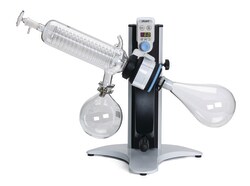Evaporators
Evaporators for dewatering, concentration, and crystallization processes; includes centrifugal and parallel designs, and accessories and replacement parts such as cold traps, condensers, expansion and extraction vessels, holders and stands, and more.
Evaporators and concentrators are used to remove solvents from samples or to reduce the size of samples using some combination of heat, vacuum, and movement.
- Rotary evaporators incorporate several components to perform evaporation efficiently and gently:
- A heated liquid bath (to warm the sample)
- A motorized rotator (to contain the vessel that holds the sample)
- A vacuum system (to create negative pressure that draws the vapor)
- A condenser (to contain the vapor and facilitate condensation)
- A collection flask (to gather the condensate)
- A lift mechanism (to move the vessel in and out of the heating bath)
Most commercially available rotary evaporators incorporate most of these basic features. Other options include:
- Choice of condensers and traps
- Digital controls and displays
- Motorized or manual lifts
- Regular or safety-coated glassware for processing hazardous materials
Centrifugal evaporators are used to remove solvents from many samples at a time. This commonly involves samples in microplates.
Typically, the unit includes:
- A vacuum pump
- A centrifuge chamber (into which the samples are placed)
- A cold trap or solvent condenser (placed between the vacuum pump and the centrifuge)
The process:
- The pressure in the centrifuge is lowered, which also lowers the solvent’s boiling point
- The samples will boil when the boiling point is below the temperature of the holder
- The solvent is rapidly removed without actually heating the samples
- The centrifugal force creates a pressure gradient so that samples boil from the top down
Vacuum concentrators use a combination of vacuum, dry heat, and vortex motion to hasten the evaporation of multiple samples. Some models also blow nitrogen gas over the sample surfaces to reduce the pressure immediately above the sample, which also speeds evaporation.
The samples may be dried completely or reduced to a specific volume. The dry heat eliminates the possible contamination from a water bath.



























